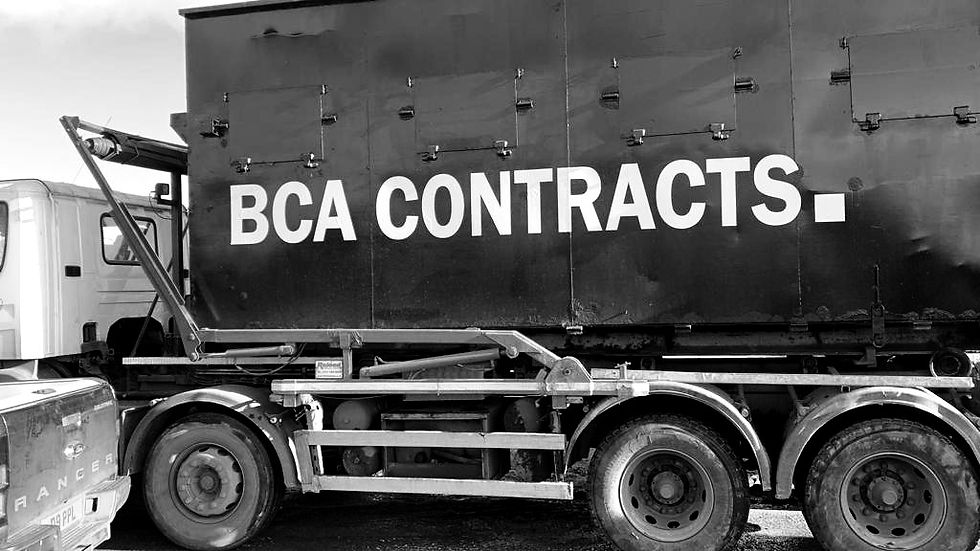The End of the Line: Where Does Asbestos Go After Removal?
- BCA Contracts
- Feb 26
- 3 min read
Asbestos removal is a critical step in protecting public health, but what happens to this hazardous material once it's been carefully extracted? It doesn't simply vanish. It embarks on a tightly controlled journey to its final resting place: a licensed landfill site.
Let's delve into the process and the crucial role landfill sites play in safely managing asbestos waste.
From Removal to Burial: A Controlled Journey
Imagine a scenario: Asbestos is discovered in an old building slated for demolition. A licensed asbestos removal contractor is called in.
Here's the typical chain of events:
Safe Removal & Packaging: The contractor carefully removes the asbestos, following strict safety protocols to minimize fibre release. The waste is double-bagged in heavy-duty, UN-approved polythene bags and sealed securely.
Secure Containerisation: These bags are often placed within a lockable skip or a UN-approved Intermediate Bulk Container (IBC) for added protection during transportation.
Documentation: A hazardous waste consignment note is meticulously completed, detailing the waste type, quantity, source, and destination.
Transportation: A licensed carrier transports the waste to a designated landfill site, complying with the Carriage of Dangerous Goods Regulations.
Arrival at the Landfill: The landfill site operator verifies the documentation and inspects the waste to ensure it meets acceptance criteria.
Safe Burial: The asbestos waste is carefully buried in a designated area within the landfill, typically covered with a thick layer of soil and other materials to prevent any future disturbance or fibre release. This area is often called a "cell."
Ongoing Monitoring: The landfill site is subject to ongoing environmental monitoring to ensure no asbestos fibres are released into the air or water.

Landfill Sites: The Final Resting Place and Key Operators
Landfill sites licensed to accept asbestos waste are specifically engineered and operated to minimize the risk of environmental contamination. These sites often have impermeable liners to prevent leachate (contaminated water) from seeping into the groundwater.
Several companies operate these specialized landfill sites in the UK. Some prominent examples include:
Biffa: Biffa Waste Services is one of the UK's largest waste management companies, operating numerous landfill sites across the country, some of which are licensed to accept asbestos waste.
Veolia: Veolia is another major player in the waste management industry, providing comprehensive waste management solutions, including landfill disposal for hazardous materials like asbestos.
FCC Environment: FCC Environment also manages landfill sites that are permitted for asbestos disposal.
The Role of Landfill Site Owners
Landfill site owners like Biffa, Veolia, and FCC Environment have a crucial responsibility to:
Operate within Permit Conditions: They must adhere to strict operating permits issued by the Environment Agency.
Ensure Proper Burial: Guarantee that asbestos waste is buried safely and securely, minimizing the risk of fibre release.
Monitor Environmental Impact: Continuously monitor air and water quality to detect any potential asbestos contamination.
Maintain Accurate Records: Keep detailed records of all asbestos waste received, including the source, quantity, and burial location.
Why Landfill is Still the Predominant Solution
While research into alternative asbestos disposal methods continues (such as vitrification), landfill remains the most widely used and readily available option for several reasons:
Cost-Effectiveness: Landfilling is generally the most cost-effective disposal method compared to more advanced technologies.
Established Infrastructure: A network of licensed landfill sites already exists across the UK, equipped to handle asbestos waste.
Proven Safety Record: With proper management and engineering controls, landfill can provide a safe and reliable method for isolating asbestos waste.
Looking to the Future
While landfill is currently the primary disposal route, ongoing research and development are exploring alternative methods that could potentially offer more sustainable solutions. In the meantime, proper management, strict regulatory oversight, and responsible operation of landfill sites remain paramount to ensuring the safe and permanent disposal of asbestos waste, protecting both human health and the environment.


Comments